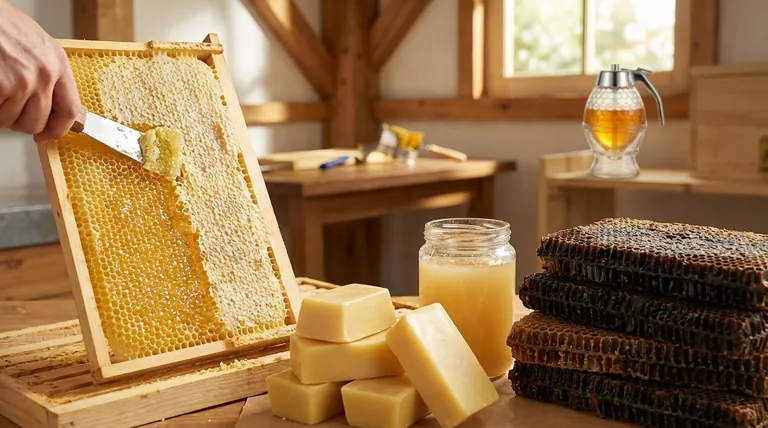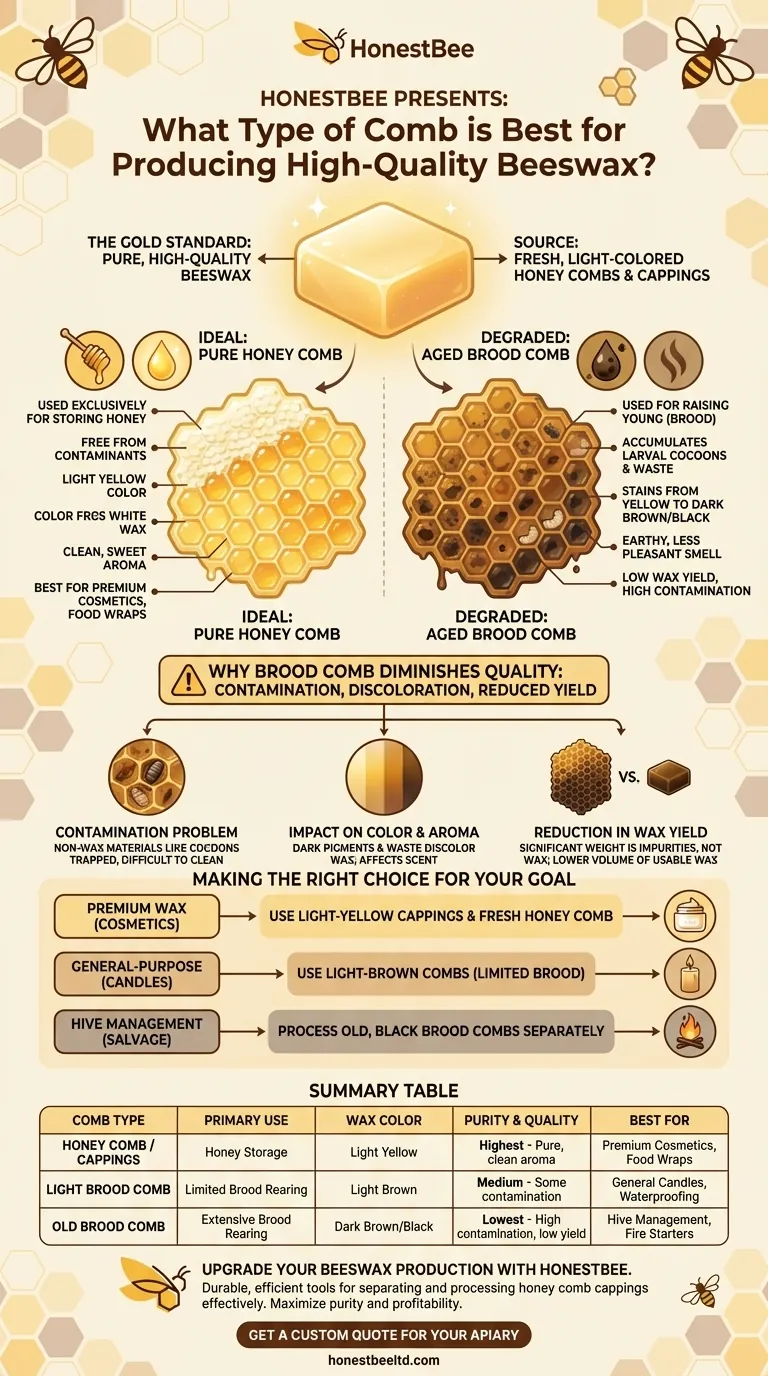The highest quality beeswax comes from fresh, light-colored combs that have been used exclusively for storing honey. These combs, particularly the wax cappings removed during honey extraction, are the purest source and yield the most valuable product.
The essential distinction for beeswax quality is not the type of bee, but the comb's purpose within the hive. Wax from honey storage areas is pure and valuable, while wax from brood-rearing areas is progressively contaminated, reducing both its quality and yield.

Honey Comb vs. Brood Comb: A Tale of Two Waxes
The journey of beeswax from a pristine structure to a less desirable material is tied directly to its use by the colony. Understanding this lifecycle is key to producing a high-quality product.
The Ideal Source: Pure Honey Comb
Bees use fresh wax to build cells for storing nectar, which they then cure into honey. They seal these cells with fresh wax "cappings."
This honey comb and its cappings are the gold standard. Because they have only ever been in contact with honey, they are free from the contaminants associated with raising young bees.
This wax is typically bright yellow and has a clean, sweet aroma, making it ideal for high-end applications like cosmetics or food wraps.
The Degraded Source: Aged Brood Comb
When bees use comb to raise their young (the brood), the nature of the wax changes fundamentally with each generation.
With every bee that hatches, a tiny larval cocoon and other metabolic wastes are left behind and embedded into the cell wall.
This process stains the comb, gradually turning it from yellow to a deep brown and eventually black over several seasons of use.
Why Brood Comb Diminishes Beeswax Quality
The desire to use every bit of comb from a hive is understandable, but processing old brood comb introduces significant problems that compromise the final product.
The Problem of Contamination
The primary issue with brood comb is the accumulation of non-wax materials, specifically the larval cocoons.
These impurities become trapped within the wax matrix. When you render (melt) this comb, these contaminants are released, creating a darker, dirtier wax that is difficult to clean.
The Impact on Color and Aroma
The color of beeswax is a primary indicator of its purity. The dark pigments from the cocoons and waste materials in brood comb will discolor the rendered wax, making it far less saleable.
This contamination also affects the scent, often imparting a less pleasant, "earthy" smell compared to the sweet fragrance of pure cappings wax.
The Reduction in Wax Yield
Old, black combs are heavy with impurities. This means a significant portion of their weight is not wax.
As a result, you will render a much lower volume of usable wax from a dark brood comb compared to an equivalent amount of fresh honey comb.
Making the Right Choice for Your Goal
Select your combs based on your intended outcome. Segregating combs by age and type before rendering is the most critical step for controlling the quality of your beeswax.
- If your primary focus is premium, cosmetic-grade wax: Use only the light-yellow wax cappings from honey extraction and any fresh, undrawn honey comb.
- If your primary focus is general-purpose wax for candles or waterproofing: You can process light-brown combs that have seen limited brood cycles, but keep them separate from your premium cappings.
- If your primary focus is simply hive management and wax salvage: Process old, black brood combs separately, expecting a low yield of dark wax suitable only for less demanding applications like fire starters.
By strategically selecting your combs, you gain direct control over the quality and value of your final beeswax product.
Summary Table:
| Comb Type | Primary Use | Wax Color | Purity & Quality | Best For |
|---|---|---|---|---|
| Honey Comb / Cappings | Honey Storage | Light Yellow | Highest - Pure, clean aroma | Premium Cosmetics, Food Wraps |
| Light Brood Comb | Limited Brood Rearing | Light Brown | Medium - Some contamination | General Candles, Waterproofing |
| Old Brood Comb | Extensive Brood Rearing | Dark Brown/Black | Lowest - High contamination, low yield | Hive Management, Fire Starters |
Upgrade Your Beeswax Production with HONESTBEE
Producing premium, high-value beeswax starts with the right equipment. HONESTBEE supplies commercial apiaries and beekeeping equipment distributors with the durable, efficient tools needed to separate and process honey comb cappings effectively.
We help you maximize the purity and profitability of your wax harvest. Contact our experts today to discuss wholesale supplies tailored to your operation's scale.
Get a Custom Quote for Your Apiary
Visual Guide

Related Products
- Honeycomb Style Drip Free Honey Dispenser
- Electric Flatting and Embossing Machine with Tray for Beekeeping
- Honey Wax Separating Wax Press with Metal Screw Wax Separator Machine
- Extra Wide Stainless Steel Honey Uncapping Fork with Scraper Beekeeping Tool
- Stainless Steel Manual Honey Press with Guard for Pressing Honey and Wax
People Also Ask
- What is the purpose of a honey bowl and dipper setup? Achieve Mess-Free, Elegant Honey Dispensing
- Is refrigeration necessary for storing honey? Avoid spoiling texture and quality
- Why use a honey drizzler? Achieve Perfect, Mess-Free Drizzling Every Time
- What are the benefits of squeeze bottles for honey packaging? Unlock Mess-Free Convenience & Control
- Can a honey gate be reused, and how should it be stored? Ensure Longevity for Your Honey Harvests



















